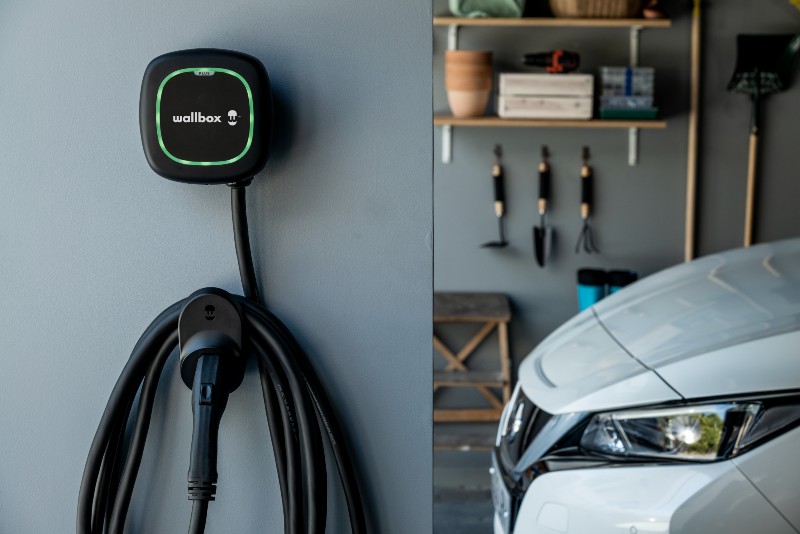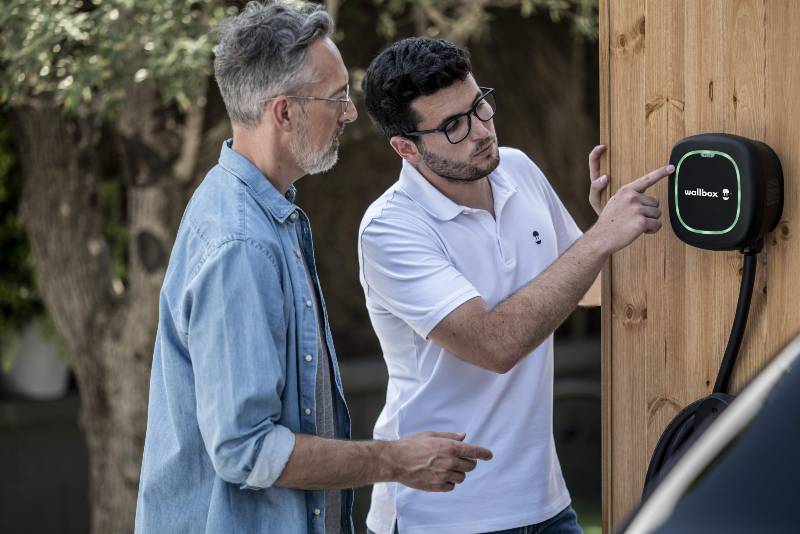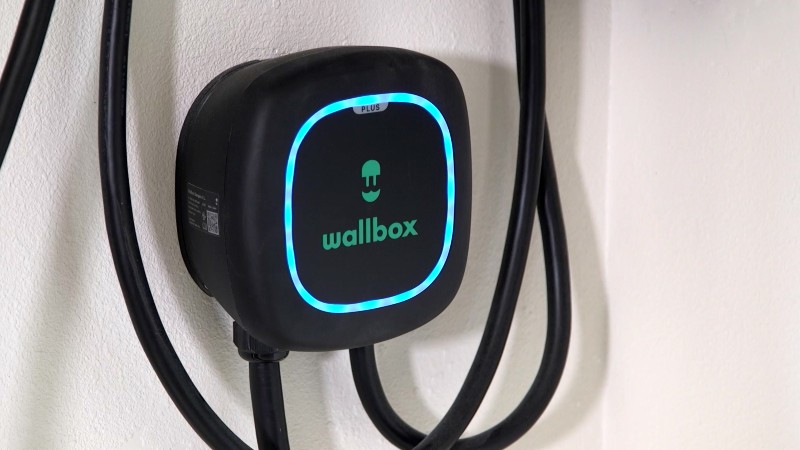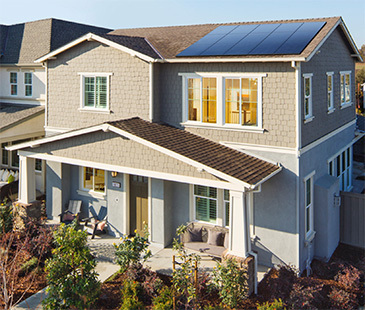Tips for Safely Charging an Electric Vehicle at Home

Charging an EV at home is a simple process, but there are safety measures you’ll want to carefully consider. By selecting the right equipment, ensuring correct installation, understanding the charging process, and following safety guidelines, EV owners can enjoy the convenience of home charging an EV while contributing to a cleaner future.
At the end of 2021, there were around two million EVs on American roads, including plug-in hybrid vehicles (PHEVs). This number is growing as EVs become an increasingly popular choice for consumers, though some users are unaware of the fire and electric shock hazards associated with charging EVs at home. Ford, Hyundai, and BMW have all had recent safety recalls due to faulty lithium-ion batteries.
That’s why it is crucial to understand the best methods for safely charging your EV also extend the life of your vehicle’s battery and help protect your home and car.
At SunPower, our experts are here to explain the ins and outs of charging your EV. Keep reading to learn more about what you need to install an EV charger, how to charge an EV, and best practices for safe charging.
What do you need at home to charge an EV?
Charging an EV at home is not only convenient, but can also reduce your carbon footprint if you use solar panels to charge your electric car. Smart charging could reduce carbon emissions by 8-14%.
The exact equipment you need depends on the make of your car, but there are a few items every EV owner needs.
EV charging station: Think of it as the heart of your home charging setup, connecting your EV to the electrical grid.
Electrical panel upgrade: Depending on the capacity of your home’s electrical system, you might need an upgrade to accommodate the power requirements of your EV.
Dedicated circuit: To charge your EV safely and efficiently, you need a dedicated circuit for your EV charger. This provides a direct power supply, reducing the risk of overloading other circuits in your home. You can charge your car worry-free, knowing that the direct power supply is less likely to interfere with other electronic devices or appliances you’re using.
Outdoor-rated charging station: If you park your car outside, or want to charge your EV in your driveway, you’ll need an outdoor-rated charging station. These stations are designed to withstand the elements and provide reliable charging regardless of the weather.
Licensed electrician: While you may be eager to set up your home EV charging station, it’s always wise to hire a licensed electrician for installation. A qualified electrician with experience installing EV chargers has the expertise to install a charging station correctly and, above all, safely.
Setting up your home charging station can be a relatively straightforward process, provided that you have all the right tools and the right experts to help you along the way.
How do you charge an EV at home?
Once you have all the necessary equipment installed, you’ll be ready to charge your EV. It can be as easy as plugging in your mobile phone, but there are a few important considerations to make. Follow these guidelines to make the process as smooth as possible.
Choose the right electric car charging equipment
Different EVs require different equipment to charge, usually with varying voltage ranges. There are three levels:
Level 1 EV Charging: Typically found at homes and workplaces, Level 1 chargers are sometimes called trickle chargers. They provide three to five miles of electric range per hour of charge. Level 1 chargers provide two amps of power, plugged into any standard outlet with 120V.
Level 2 EV Charging: Level 2 EV chargers provide faster charging from a 240-volt outlet. They provide 12-80 miles of range per hour of charging, which means they can fully charge in 6-12 hours. These chargers can be found at homes and workplaces, but sometimes also in public spaces, like at a gas station.
Level 3 EV Charging: Public chargers are usually Level 3 chargers, providing DC Fast Charging. They provide 3-20 miles per minute, which means they have a quicker charge to full battery. They’re best for high-speed electric vehicles. However, they are not necessary for the average electric car.
When choosing an EV charger, make sure you consider the needs of your vehicle and your typical energy usage.
Prepare your home
Before installing your EV equipment, you’ll need to make sure your home’s electrical infrastructure can support it. Taking these steps can provide a safe and efficient charging experience.
First, assess the electrical panel capacity. Older homes may require an upgrade to accommodate EV charging. Next, verify that you have a dedicated circuit available to prevent circuit overload while charging. If needed, your electrician can help with panel upgrades and install dedicated circuits.
An electrician can also assess your home’s infrastructure to evaluate the wiring, outlets, and overall electrical system to make sure it meets safety standards and recommend any necessary upgrades.
Install your charging station
A licensed electrician has the know-how to determine the best location for your charging station to carry out the installation process. This includes factoring in proximity to your parking space, accessibility to electrical connections, and the layout of your property.
They can professionally install the charging point to maximize safety and effectiveness, handling everything from sorting out the wiring to mounting the charging station, following industry standards and local electrical codes in the process.
Your electrician should also perform a safety test to verify the electrical connection is secure.
Connect your EV
Once your EV charging station is installed, you can start charging. Follow these simple steps for smooth results:
Position your vehicle: Park your EV within reach of the charging station, where the charger cable can comfortably reach the charging port.
Review the instructions: Your EV charging station will come with manufacturer’s instructions. Read them carefully before using your new equipment.
Consult the vehicle’s manual: Your EV owner’s manual will also have specific guidance. Each manufacturer has different processes, so it’s vital to read the instructions to learn where the port is and how to open it, as well as any additional information you should know.
Connect the charging cable: Grab the charging cable and plug it into the charging station’s outlet, then connect the other end to the EV’s charging port, checking that the connections are secure.
Confirm charging: Check the charging station’s display or indicator lights to confirm charging has begun. You may need to press a button to begin the charging process, depending on the product.
Monitor and manage charging
As you charge your EV, you’ll want to check on its progress. Use the charging station’s display to monitor the process and ensure ongoing charging. Some charge stations provide real-time information on charging rates and estimated completion time, and there may also be a mobile app where you can check progress and set up charging schedules.
Above all, be sure to adhere to all safety requirements, including charging duration limitations and manufacturer’s guidelines. The U.S. Fire Administration also has some helpful tips on fire safety while charging an EV.
Disconnect and store charging cable
When your EV has finished charging, it’s important to disconnect and store the charging cable properly.
First, check the charging status to make sure the process is complete. Turn off the charging station if needed, then safely and gently remove the charging cable. Properly coil the cable, then store it away where it won’t be a tripping hazard. Most stations have a built-in hook. It should also be kept out of rain or excessive heat and sunlight, in a cool, dry place.
What are the biggest EV charging hazards
EV charging is generally safe, but there are some common hazards that all EV owners should be aware of. Here are some dangers to keep in mind:
Overloading electrical circuits
Plugging in your EV to charge draws a significant amount of power. If your home is not designed to handle the additional load, it can lead to potential electrical hazards. You can mitigate this risk by consulting with a licensed electrician to assess your electrical panel’s capacity.
Faulty charging equipment
Using malfunctioning or damaged charging equipment can pose a significant risk. Always purchase charging stations from reputable manufacturers, and regularly inspect the charging cable for obvious signs of damage or excessive wear.
Insufficient electrical infrastructure
With an inadequate power supply, there may be charging disruptions or equipment damage. Before installing an EV charging station, make sure your home’s electrical system can accommodate the additional load.
Inadequate ventilation
As with all electronics, EV chargers generate heat. This is especially true with high-power L3 chargers. It’s important to provide adequate ventilation in the charging area and avoid charging in enclosed spaces or near flammable materials.
Inclement weather
Extreme weather conditions can also pose challenges for EV charging. Whether it’s heavy rain, snow, or extreme temperatures, make sure your charging equipment is protected from weather hazards. If charging outdoors, confirm your charging station is suitable for outdoor use.
User error
Misuse during charging can lead to accidents or damage. Follow the manufacturer’s instructions for your charging equipment and your vehicle’s owner manual to ensure proper and safe usage. Incompatible charging cables, for example, can greatly increase the risk. Never attempt to modify or repair equipment yourself.

15 tips for charging your EV at home
No matter how comfortable you feel charging your EV, following these best practices is important if you want to charge safely and efficiently.
Choose the right equipment:
Select a charging station that meets your needs, considering factors like charging speed and vehicle compatibility.
Install your charging equipment correctly:
Hire a licensed electrician to ensure proper installation.
Monitor charging sessions:
Monitor the process to track energy delivered, charging rate, and estimated completion time.
Charge during off-peak hours: Schedule your charging sessions during off-peak hours, typically late at night or in the early morning, to take advantage of lower electricity rates and help reduce strain on the electrical grid.
Maintain proper ventilation:
Make sure your charging area has adequate ventilation to reduce the heat generated during charging.
Follow basic safety guidelines:
Adhere to general safety precautions like keeping the area clear of flammable materials, avoiding charging in wet conditions, and unplugging the charger when not in use.
Follow manufacturer’s guidelines:
Refer to the manufacturer’s instructions for both your charging equipment and your EV to ensure proper usage.
Purchase certified charging devices:
Look for charging devices certified by a testing laboratory to ensure they are safe and reliable.
Use dedicated outlets:
Plug Level 1 chargers directly into outlets designed to handle the amperage. Never use multiplug adapters or extension cords.
Install a residual current device (RCD):
Consider installing an RCD or ground fault circuit interrupter (GFCI) with the charging unit to detect faults and protect against electrical hazards.
Keep components out of reach of children:
Store the charging connector and cable in a safe place away from children to prevent accidents and damage.
Follow vehicle maintenance guidelines:
Regularly inspect and maintain the components of your charging station according to manufacturer’s recommendations for optimal performance and safety.
Protect the charging station outlet:
Use a protective cover or cap to prevent water and dust from entering the power outlet.
Avoid charging to the max:
Charging your EV up to 100% capacity regularly may strain the battery pack over time. Consider charging to a slightly lower level (about 80%), which should cover your daily commute.
Time your charge:
Take advantage of smart charging features or schedule your charging sessions to optimize convenience and energy management.
Charge ahead with confidence: Trust SunPower
Charging your EV at home is a straightforward process, as long as you prioritize safety. By selecting the right equipment, ensuring proper installation, and being familiar with charging processes, you can enjoy the benefits of EV charging at home. Embracing these safety tips not only provides convenience and savings, but can also contribute to a cleaner, greener future.

SunPower is changing the way our world is powered by making solar and storage more accessible to everyone. With nearly 40 years of dedicated solar experience, we're the top-rated U.S. solar company with over 15,000 five-star reviews.*Based on public solar providers in the U.S. Includes average of BBB, Yelp, ConsumerAffairs, BestCompany, Google, Solar Reviews and Energy Sage review scores as of 7/1/23. Based on reviews from BBB, Yelp, ConsumerAffairs, BestCompany, Google, Solar Reviews and EnergySage review scores as of 10/22/23. If you're considering installing solar panels, energy storage, or EV charging at your home, make sure you talk to SunPower.
At SunPower, we understand the importance of a seamless and safe EV charging experience. That’s why we’ve teamed up with Wallbox to offer you EV charging that is convenient, affordable, and sustainable. Plus, you can help make an even bigger difference for the planet, by going solar with SunPower. You’ll not only be able to charge your EV with clean, solar energy, but you can also save money on your electric bill.
Together, let’s drive toward a greener tomorrow. Find out more about Wallbox EV chargers today.
FAQs - Tips for safely charging an electric vehicle at home
Is it safe to charge an EV at home?
Yes. While charging lithium-ion batteries at home can present certain risks, such as fires and a potential shock hazard, by following best practices, including working with a licensed electrician and following all instructions for your specific charger and EV, you can charge safely at home.
How can I reduce my energy costs when charging my EV at home?
Charging your EV battery will increase your energy usage, adding to the cost of electricity. You can keep costs down by charging off-peak to take advantage of reduced electricity rates. Plus, you can set an optimal battery charge that's below 100%, keeping energy costs down while also helping to avoid battery degradation. Want to save even more? Consider going solar and generating your own clean electricity to power your EV.
Can a car charger be installed at any property?
Generally, you can install an EV charger at any property. Most domestic properties have a maximum charging rate of 7kW, which is enough for a Level 1 charger. Some homes may need electrical upgrades to accommodate EV charging, but adding the necessary components and installing a car charger is usually possible.

